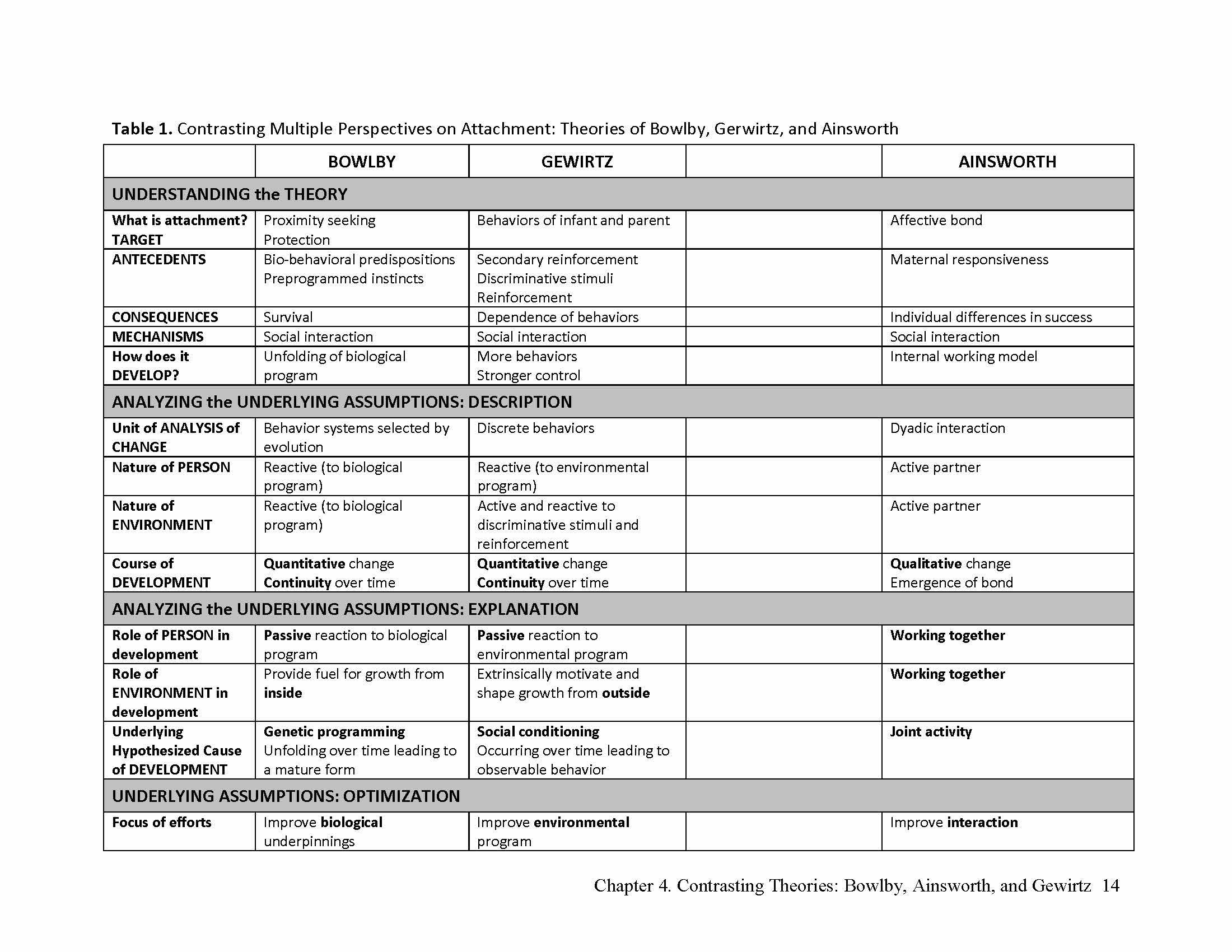15.8: Why are the theories of Bowlby, Gewirtz, and Ainsworth so very different?
- Last updated
-
-
Save as PDF
Although they have in common a focus on the construct of “attachment,” these three theoretical perspectives were selected to illustrate that theories ostensibly focusing on the same phenomenon can be very different from each other. Table 4.3 provides a side-by-side comparison of these theories, considering how each one would answer fundamental questions about attachment—what it is, its antecedents, consequences, the mechanisms that connect these processes, how it develops. For example, in response to the question, “What is attachment?”, Bowlby would describe it as a system preprogrammed by biobehavioral predispositions selected by evolution that allows the newborn (and later the infant) to seek proximity and protection from its caregiver when distressed. Gewirtz sees it as a set of responses systems that are under the mutual control of infant and caregiver; and Ainsworth sees it as a dyadic affective bond, shaped by maternal sensitive responsiveness.
As is clear from Table 4.3, Bowlby emphasizes species-wide biology and genetic programming, whereas Gewirtz highlights social conditioning and environmental programming. Ainsworth focuses on different pathways that species-wide predispositions can take depending upon the contextual conditions in which they emerge. About the only thing that all three theorists agree on is that the mechanisms of effects can be found in social interactions, but Bowlby emphasizes the regularity with which they play out, Gewirtz posits that the are contingent antecedent-consequence chains, and Ainsworth focuses on how the tenor of these interactions leads infants to construct different kinds of “working models” about the social worlds they inhabit.
These differences are not just academic. They represent fundamental differences in the way these theorists think about human functioning and development. Highly instructive in this regard is Gewirtz’s analysis of Bowlby’s and Ainsworth’s theories, presented in the second part his chapter (Gewirtz, 1969, p. 166-173). It is interesting to see the evolutionary-ethological perspective through the lens of learning theory, as exemplified by how Gewirtz chooses to label it—“Pre-learning theories.” These disagreements came to a scientific head in a series of critiques, rejoinders, and replies exchanged by Gewirtz and Ainsworth (Ainsworth & Bell, 1977; Gewirtz & Boyd, 1977a, 1977b) following a study Ainsworth published with Bell in 1972 (Bell & Ainsworth, 1977). The fundamental disagreement was straightforward and focused on a simple question—“Does maternal prompt responsiveness to an infant’s crying increase or decrease the likelihood of future crying?” From a learning theory perspective (and consistent with pediatricians’ advice of the day), responsiveness is hypothesized to reinforce crying and so increase its frequency and duration—if a mother wishes to see crying decrease, she should extinguish it by ignoring it. From Ainsworth’s perspective, sensitive responsiveness should reduce crying, because it allows the infant to build a generalized expectation that care is forthcoming, and this security should provide equanimity and foster other means of communicating distress.
No empirical resolution of this disagreement was reached through this series of exchanges, but they are very revealing about how easily discussions about data and statistical analyses can flare into meta-theoretical disputes. Particularly informative are differences in opinion about the kinds of studies (design, data, and analysis) that could actually answer the target question. Gewirtz and Boyd (1977) outline the empirical requirements of an investigation of a learning theory account of maternal reinforcement of expressive and “non-distress” crying, and point out the differences between these kinds of studies and the one conducted by Bell and Ainsworth (1972). Not surprisingly, disagreements continue about the interpretation of date, conclusions that can be drawn, and practical implications. The two camps seem to be operating in different worlds, with little common ground. One factor that made these discussions more challenging is the assumptive bases of these two groups of researchers, and the fact that they reflected different meta-theoretical worldviews.





